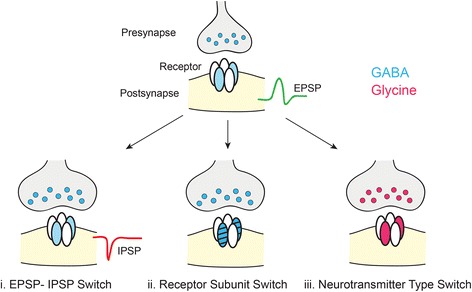Fig. 4.

Maturational ‘switches’ at inhibitory synapses. i) GABAergic and glycinergic transmission is initially depolarizing early in development due to the high intracellular chloride concentration within the postsynaptic cell. Reversal of the chloride gradient with maturation leads to hyperpolarization upon activation of GABA and glycine receptors [104]. EPSP: excitatory postsynaptic potential, IPSP: inhibitory postsynaptic potential. ii) During maturation, the composition of GABA and glycine receptor pentamers switches to incorporate different subunits, typically resulting in faster synaptic transmission [122, 123]. iii) Inhibitory circuits can also undergo a neurotransmitter type switch accompanied by a change in postsynaptic receptor expression. The transition from GABA-releasing to glycine-releasing is more common, but the reverse has also been documented [112, 114], see text for more details
